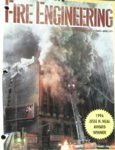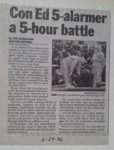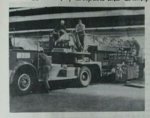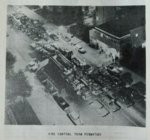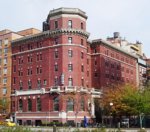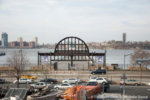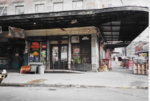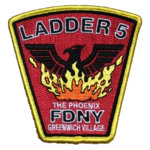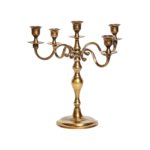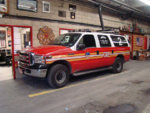LADDER 5 P 12
STUDYING
I’ve had some wonderful meals in the firehouse, and I know that every joint had a couple of stand out chefs that could put a real nice meal on the table, better than you can find at any restaurant, but I enjoyed E 24’s ECC Bobby Beddia’s style of cooking. Bobby was a good looking rugged type of guy, a real lady charmer. In fact he was hired as a model for an outdoors magazine ad and flown to Maine, he was photographed wearing an outdoorsy watch and his beautiful smile. He had a unique style of cooking, his tasty and hearty dishes were something between a stew and a soup. Bobby had the knack of compiling different foods like sausage, pasta, zucchini, tomatoes, beans and onions chopped up and incorporating them together, placed in a bowl and lightly covered with a chicken or vegetable stock, not enough stock to make it a soup. With fresh bread from the local bakery his meals were ‘stick to the ribs’ outstanding especially during the cooler weather. Even today if I stumble upon a lunch at a restaurant and serve a similar type meal, it brings back warm memories of Bobby’s dishes.
I think the Ladder Company Chauffeur position is by far the best, I could have done twenty years standing on my head. With the exception of a job, the many elevator, nuisance calls and water leak calls I could just stand fast on the rig which was especially nice on freezing night tours, “Don’t worry Lou, when you get back I’ll have the cab nice and warm for you”. I was very comfortable in my position but I was beginning to feel a little antsy.
Now that I moved to Battery Park City, two blocks from the World Trade Center with my new wife, I went from having the longest commute to walking distance of the firehouse. I also packed it in with my side work gig shuttling an oil truck. Now, enjoying the extra free time and with seventeen years on I thought that this would be a good time to start studying for the next lieutenants promotional exam that was a little over two years away. Little did I know it would become an engrossing lifestyle.
Studying I found out is a lifestyle. During my time on the job, I remember other firefighters that were committed to studying, and like golf, that was all they talked about. Most were in “study-groups” where these guys would meet regularly at somebody's home throwing questions at each other and discussing the study material. They would talk about the upcoming week ‘study group’ gathering as if it was a tailgate party. I thought it was about time I became one of those guys.
To start with, I bought all the “books” I needed from a guy on Staten Island that had a printing business and sold firefighters the complete set of official manuals. It cost a couple of hundred dollars to get going, the manuals came in a large tied bundle with no binders, the bundle was at least about a foot high, maybe a little more of just stacked paper. If you wanted “three ring holes” punched in, that was an additional cost but that would help to sort and organize all the different manuals and so I invested in six three inch loose leaf binders.
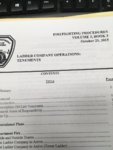
I could go on and list the subjects and topics, the various manuals of regulations, communications, evolutions, training bulletins and tools, All Unit Circulars, Tactics and Procedures for every conceivable type structure found in NYC, Engine operations, Ladder operations, fires in Private Dwellings and taxpayers to Hi-rise, subways, Elevator and every other emergency you can imagine, Con-Ed, personnel management, EMS, Guide to Company Journals and on and on.
At first hand the subject matter appeared overwhelming, this was like trying to comprehend an encyclopedia collection. In addition every quarter was more info on “changes” and “updates” that needed to be added to the books and the old stuff extracted. I’m told, that was very important since the people who create the exam are usually looking for ‘new’ information, especially if the information was updated they could use the newer material as a question.
And so I committed to studying everyday for at least an hour. Many of the lieutenants and students I met told me that all of a sudden there is a transformation where you start becoming consumed learning and yearning for more and that is true. I couldn’t wait to sit down and crack open a book and I studied more than an hour easily. I became obsessive. The Lieutenants test comes around usually every two years and I did not study for the previous exam. But like a new hobby I found myself reading and studying almost every chance I could whether at home, in the firehouse or while out on the rig while the troops were inspecting buildings.
When I was off, I attended two separate courses that prepared you for the Lieutenants and Captains exam, they cost a few bucks to get into, but well worth the investment. Rented large halls with round tables that seated four were occupied by about forty students either studying for the Lieutenants or Captain Exam. The first course was “Fire Tech” and the second “Fire Command” these courses were held by an FDNY Officer who was highly successful in passing promotional exams sharing his test taking strategies and approach.
The structured preparatory classes were conveniently given at various locations and times every week to accommodate the varying firefighter schedules. Both courses provided you with study guides and lists, test taking strategies, and a weekly structured study schedule that was reviewed at the next class. I looked forward to attending these classes, in fact I even started to “record” the lecture on a small cassette recorder for enhancement, it was a common practice among the students. And from the class I was able to hook up with fellow students and formed a couple of study groups.
One of the best suggestions I received was from a very sharp lieutenant in E 24, and it is still useful today, Lt. Rosie told me to jot down the date in the upper right hand corner of whatever subject material you were reading when you completed it. It was a quick reference of the last time you read that subject and a timeline when you needed to refresh. There were subjects that I entered at least eight different dates, and that was what it took. The other smartest tip I recall was not to “highlight” anything until after you have read the subject three times. And that was true, it was hard to hold back on the highlighter, but after about the third time reading the material, your memory recalled the next information you were about to read, almost like watching a movie three times, you know what the next lines will be.
Another great technique tip I learned from my L 38 buddy who was now the Captain of R 4 Brian Hickey was to create a notebook with dedicated pages to jot down any reference to colors mentioned in any of the numerous manuals, same with any reference to numbers, any time you read “never” or “always”. He also broke down references to hours, days, dates, quarterly, semi annual, annual references. Brian's methodology was very thorough, he was a great inspiration.
I really enjoyed studying, it became my lifestyle, and I recall reading material that I knew like the back of my hand and looking for any nuance that I may have overlooked or not remember. I had the subject matter down ice cream cold.
In August of 2001 “Fire Tech” had a one hundred question “practice exam”, like the NYC exam you were assigned a number on the exam, no name. The test was deliberately made difficult with trickery wording and questioning. Later, the following week after the exam a list of four hundred or so test takers was distributed with their score. I did very well, and was number five on the list. Now, of course, it was no guarantee that I would have had a successful Saturday taking the exam, I could have had a complete fall out, but I was confident and psyched to tackle the upcoming lieutenants test that was scheduled two months away, bring it on, baby. Except nobody knew of the impending attack of September 11th.
EPILOGUE: Subsequently the October exam was canceled, and many months after the 9/11 attack the Lieutenants exam was re-scheduled, every member of my study groups went on to become fine lieutenants and Captains. The young probie I “tutored” who had ‘cop’ time, believe it or not he would be eligible to take the exam, today he is a Captain.
I did not have the chance to take the promotion exam because I had to retire. However, after retirement I did take the New York State Fire Instructor Course, did very well and became a National Certified Fire INstructor that opened many doors for me eventually.
Thanks for reading, hope you enjoyed this ditty...KMG-365.

